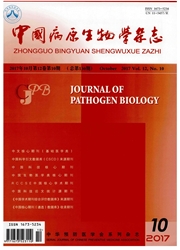

 中文摘要:
中文摘要:
目的进一步研究吡喹酮对裂头蚴感染小鼠的治疗效果。方法将80只小鼠随机等分为10组,每只小鼠经口感染8条裂头蚴;1~5组小鼠分别在感染后1、2、4、6和8周应用吡喹酮治疗(总剂量2 800mg/体重kg,3次/d,疗程3d),治疗后1周剖杀;6~9组小鼠均在感染后1周以相同剂量吡喹酮进行治疗,分别在治疗后2、4、6和8周剖杀;第10组小鼠仅灌服蒸馏水,感染后第9周剖杀。检获裂头蚴,计算各组平均检获虫数和减虫率。结果裂头蚴感染后1、2、4、6和8周,小鼠应用吡喹酮治疗1周(1~5组)的减虫率分别为39.00%、18.00%、17.13%、14.00%和8.38%(P〈0.05);减虫率具有随感染后开始治疗时间的延迟而降低的趋势(P〈0.05)。小鼠感染裂头蚴后1周,应用吡喹酮治疗后1、2、4、6和8周(1、6~9组)的减虫率分别为39.00%、29.63%、18.75%、14.00%和6.25%(P〈0.05),减虫率具有随治疗后时间的延长而降低的趋势(P〈0.05)。感染裂头蚴后1~8周小鼠应用吡喹酮治疗和感染1周后小鼠应用吡喹酮治疗1~8周,减虫率变化趋势一致,即随感染后时间的延长而降低。结论吡喹酮对小鼠裂头蚴感染无明显疗效。
 英文摘要:
英文摘要:
Objective To further study the therapeutic effectiveness of praziquantel on mice infected with Sparganum mansoni.Method Eighty mice were randomly divided into 10groups(groups 1-10,8mice each)of the same size.Each mouse was orally infected with 8spargana.Groups 1-5were treated with praziquantel(2 800mg/kg in 3doses per day for 3days)at 1,2,4,6,and 8weeks post-infection(wpi),respectively,and were then sacrificed at one week posttreatment(wpt).Groups 6-9were treated with the same dose at 1wpi and were sacrificed at 2,4,6,and 8wpt,respectively.Group 10served as a control and was not treated.After the infected mice were sacrificed,the spargana were recovered and counted,and the worm reduction rate was determined.Results The worm reduction rate in infected mice at 1,2,4,6,and 8wpi were 39%,18%,17.13%,14%,and 8.38%,respectively,at 1wpt(P0.05),indicating that the rate tended to decrease as the start of treatment after infection was delayed(P0.05).One wpi,the worm reduction rate in infected mice at 1,2,4,6,and 8wpt was 39%,29.63%,18.75%,14%,and 6.25%,respectively(P 0.05);the rate tended to decrease over time after treatment(P0.05).There were no statistical differences(P 0.05)in the worm reduction rate at the same time after infection for infected mice treated with praziquantel at 1-8wpi or infected mice at 1-8wpt.The worm reduction rate tended to decrease after a longer period post-infection.Conclusion Praziquantel appears to be therapeutically ineffective in treating sparganosis in mice.
 同期刊论文项目
同期刊论文项目
 同项目期刊论文
同项目期刊论文
 Analysis of structures, functions and epitopes of cysteine protease from Spirometra erinaceieuropaei
Analysis of structures, functions and epitopes of cysteine protease from Spirometra erinaceieuropaei Characterisation of the relationship between Spirometra erinaceieuropaei and Diphyllobothrium specie
Characterisation of the relationship between Spirometra erinaceieuropaei and Diphyllobothrium specie Identification of early diagnostic antigens from spirometra erinaceieuropaei sparganum soluble prote
Identification of early diagnostic antigens from spirometra erinaceieuropaei sparganum soluble prote Cutaneous gnathostomiasis with recurrent migratory nodule and persistent eosinophilia: a case report
Cutaneous gnathostomiasis with recurrent migratory nodule and persistent eosinophilia: a case report Analysis of structures, functions, and epitopes of cysteine protease from Spirometra erinaceieuropae
Analysis of structures, functions, and epitopes of cysteine protease from Spirometra erinaceieuropae Molecular characterization of a Spirometra mansoni antigenic polypeptide gene encoding a 28.7 kDa pr
Molecular characterization of a Spirometra mansoni antigenic polypeptide gene encoding a 28.7 kDa pr Characterization of Spirometra erinaceieuropaei Plerocercoid Cysteine Protease and Potential Applica
Characterization of Spirometra erinaceieuropaei Plerocercoid Cysteine Protease and Potential Applica Serodiagnosis of sparganosis by ELISA using recombinant cysteine protease of Spirometra erinaceieuro
Serodiagnosis of sparganosis by ELISA using recombinant cysteine protease of Spirometra erinaceieuro Levels of sparganum infections and phylogenetic analysis of the tapeworm Spirometra erinaceieuropaei
Levels of sparganum infections and phylogenetic analysis of the tapeworm Spirometra erinaceieuropaei Phylogenetic location of the Spirometra sparganum isolates from China, based on sequences of 28S rDN
Phylogenetic location of the Spirometra sparganum isolates from China, based on sequences of 28S rDN 期刊信息
期刊信息
